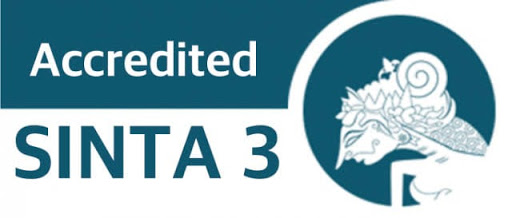THE EFFECT OF DICTOGLOSS ON STUDENTS’ LISTENING ACHIEVEMENT
Abstract
Listening is one of important skills the students should posses in learning English as a foreign language. Listening has a vital role in learning a foreign language especially in communication since most of the students’ activities involve listening. Unfortunately, students’ listening comprehension did not reach a good result. This study was conducted to reveal the effect of dictogloss to improve students’ listening achievement. The design of this study was a quasi-experimental study. The samples were chosen from the second grade students at SMA Negeri 1 Pandeglang by using purposive sampling. The experimental class was taught by implementing dictogloss, while the control class was taught without dictogloss. A test was administered as the primary instrument to collect the data. The final mean scores gained from both classes were analyzed by using t-test at a significance level of α = 0.05. It was found that the mean score of experimental class was 67.6, while the control class was 59.96. The statistical calculation of gained score revealed that the t-count was 2.53, and the t-table was 1.668 at a significant level of α = 0.05. This showed that the t-count was higher than t-table. It implied that there was a significance difference of two mean scores gained. Therefore, it could be concluded that dictogloss provided positive influence on students’ listening achievement, and it could be an alternative technique to be used in teaching listening in the classroom.
Keywords
Full Text:
PDF (ENGLISH)References
Aminatun, D., Ngadiso, N., & Marmanto, S. (2019). Applying PLEASE Strategy to Teach Writing Skill on Students with Different Linguistic Intelligence. Teknosastik, 16(1), 34-40.
Arikunto, S. (2006). Prosedur Penelitian: Suatu Pendekatan Praktik. Jakarta: PT. Runeka Cipta.
Ayu, M., & Zuraida, Z. (2020). Enhancing Descriptive Paragraph Writing Of Secondary Students Through Shared Writing. Journal of Research on Language Education, 1(1).
Fachraini, S. (2017). AN ANALYSIS OF STUDENTS’ MOTIVATION IN STUDYING ENGLISH. Getsempena English Education Journal, 4(1), 47-57.
Jacobs, G., & Small, J. (2003). Combining dictogloss and cooperative learning to promote language learning. The Reading Matrix, 3(1).
Jacobs, G., & Small, J. (2003). Combining dictogloss and cooperative learning to promote language learning. The Reading Matrix, 3(1).
Jones, D. (2008). Is there any room for listening? The necessity of teaching listening skills in ESL/EFL classrooms. In Kansai University Gaikokugo Forum, 7, pp. 15-22.
Kidd, R. (1992). Teaching ESL grammar through dictation. Tesl Canada Journal, 49-61.
Kooshafar, M., Youhanaee, M., & Amirian, Z. (2012). The Effect of Dictogloss Technique on Learners' Writing Improvement in Terms of Writing Coherent Texts. Journal of Language Teaching & Research, 3(4).
Luchini, P. L., & Arguello, M. (2009). Listening skill teaching: Some pedagogical considerations. Iranian journal of language studies, 3(3).
Mandasari, B., & Aminatun, D. (2020). Improving Students’speaking Performance Through Vlog. English Education: Journal of English Teaching and Research, 5(2), 136-142.
Morimoto, Y., & Timmers, R. (2012). The Effect of Repeated Listening on Pleasure and Boredom Responses. In Proceedings of the 12th International Conference on Music Perception and Cognition and the 8th Triennial Conference of the European Society for the Cognitive Sciences of Music (pp. 693-7).
Muliyah, P., Aminatun, D., Nasution, S. S., Hastomo, T., & Sitepu, S. S. W. (2020). Exploring Learners’autonomy In Online Language-Learning In Stai Sufyan Tsauri Majenang. Getsempena English Education Journal, 7(2).
Oktaviani, L., & Mandasari, B. (2020). Powtoon: a Digital Medium to Optimize Students' Cultural Presentation in ELT Classroom. Teknosastik, 18(1), 33-41.
Richards, J. C., & Renandya, W. A. (Eds.). (2002). Methodology in language teaching: An anthology of current practice. Cambridge university press.
Sari, F. M., Sukirlan, M., & Suka, R. G. (2013). Improving Students’listening Ability Through Dictation Technique At The First Year Students. U-JET, 2(3).
Shak, J. (2006). Children using dictogloss to focus on form. Reflections on English language teaching, 5(2), 47-62.
Sugiarti, S. (2012). Improving The Learners’ Writing Skill Through Dictogloss (A Classroom Action Research at Grade IX I of SMP Negeri 3 Ungaran in the Academic Year 2011-2012) (Doctoral dissertation, Universitas Muhammadiyah Surakrta).
Sugiyono. (2011). Metode Penelitian Kuantitatif, Kualitatif, dan R&D. Bandung: Alfabeta.
Wahyudin, A. Y., Jepri, D., Simamora, M. W., Pratiwi, I. W., & Rina, A. (2020). Penggunaan komik digital Toondoo dalam pembelajaran Bahasa Inggris tingkat sekolah menengah. Journal of Social Sciences and Technology for Community Service (JSSTCS), 1(1), 1-6.
Wajnryb, R. (1990). Grammar Dictation. New York: Oxford University Press.
Wallace, T., Stariha, W. E., & Walberg, H. J. (2004). Teaching Speaking, Listening and Writing. Educational Practices Series-14. UNESCO International Bureau of Education.
DOI: http://dx.doi.org/10.33578/pjr.v5i2.8246
Refbacks
Copyright (c) 2021 JURNAL PAJAR (Pendidikan dan Pengajaran)

This work is licensed under a Creative Commons Attribution-NonCommercial-ShareAlike 4.0 International License.
JURNAL PAJAR (Pendidikan dan Pengajaran)
Secretariat
Program Studi Pendidikan Guru Sekolah Dasar
Gedung B1, FKIP Universitas Riau
Kampus Bina Widya Km. 12,5 Simpang Baru Panam
Pekanbaru Riau Indonesia 28293
e-mail : pajar@ejournal.unri.ac.id



